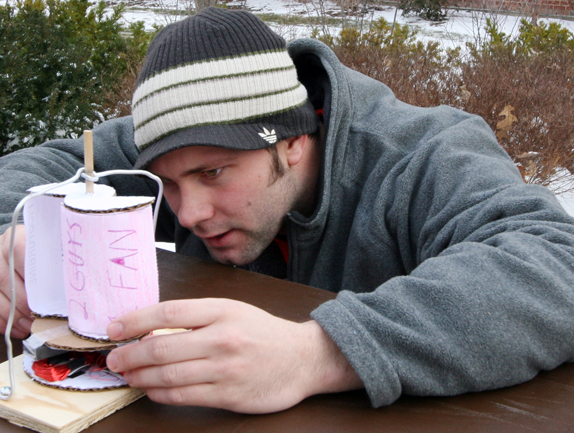 The temperature was in the teens and some students were barely dressed for the cold, but each time a strong gust blew on this icy Thursday morning, the students and physics Professor Martin Madsen practically cheered for more.
The temperature was in the teens and some students were barely dressed for the cold, but each time a strong gust blew on this icy Thursday morning, the students and physics Professor Martin Madsen practically cheered for more.
The cause of their seemingly irrational behavior? Science. Specifically, the Chemistry and Physics Departments' Alternative Energy class. This was the students' one chance to test the wind generators they had built in the lab, and they needed all the wind they could get. (Click here for a photo album.)
"This energy class is one of the neatest things we're trying this semester," says Associate Professor of Chemistry and department chair Scott Feller. "It's a new model for non-majors, where lectures and labs are combined, and we bring together the expertise of both the physics and the chemistry departments on a single theme."
Students have studied the principles of force and momentum, then applied that learning pushing a professor's car around the mall. Later this semester, they'll not only learn about bio-fuels; they'll make them. And this week they studied both wind and electricity, learning the theories behind both, then putting it all together by building their own wind generators.
"I've always wanted to teach an alternative energy class; it's my hobby," said Madsen, who rides his bike two miles to work daily, regardless of the weather. He realized an opportunity for such a class when one of his physics students told him about the freshman tutorial about alternative energy the student had taken from Associate Professor of Chemistry Ann Taylor.
"That tutorial was a lot of fun," Taylor recalled Thursday. "But practically every day I found myself wanting to teach the science between the ideas more deeply. But I'm not a physicist; while I can discuss fuels at length, electricity is more of a stretch."
So Taylor was enthusiastic when Madsen brought up the idea of "putting together a class that included both the chemistry and physics of alternative energy."
"It's great for the students to see how two different sciences give different points of view on the same topic, and how you really need both fields to understand a topic as complex as energy," Taylor, a biochemist, says. They started talking about ideas for the course and how it might be taught at the Chemistry-Physics Departments' picnic last spring, and now the class is in full swing.
"For this section, we started by talking about the wind, where it comes from, and how we can transform that energy into electricity," Madsen said as we waited for more students to venture out into the cold with generators. "They've been doing some tinkering and experimenting in the class. They're learning that what works in the lab often works differently in the real world."
Next up: bio-fuels and solar cells.
Pictured: Chad Finley ’08 works to free up the magnets on the generator he and Tom Hanewald ’09 built.